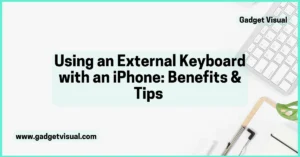In today’s tech-savvy world, having a wireless keyboard can significantly enhance your computing experience. Microsoft offers a range of wireless keyboards, but connecting them might seem daunting at first. Fear not, for in this comprehensive guide, we will demystify the process of connecting your Microsoft wireless keyboard. Whether you’re a beginner or someone looking for a quick refresher, this article is your go-to resource. We’ve broken down the steps into simple, easy-to-follow instructions, ensuring that by the end of this read, you’ll be seamlessly typing away on your Microsoft wireless keyboard.

Contents
- 1 How to Connect Microsoft Wireless Keyboard: Simplifying the Process
How to Connect Microsoft Wireless Keyboard: Simplifying the Process
1. What You Need to Connect Your Microsoft Wireless Keyboard
To embark on your wireless keyboard journey, you need a few essentials. First and foremost, ensure you have the correct Microsoft wireless keyboard model that supports wireless connectivity. Typically, these keyboards come with a small USB receiver that plugs into your computer’s USB port. Alternatively, some models use Bluetooth technology, eliminating the need for a USB receiver.
Additionally, familiarize yourself with the type of batteries your keyboard requires. Most Microsoft wireless keyboards operate on AA or AAA batteries. Always use fresh, high-quality batteries to ensure optimal performance and a longer lifespan for your keyboard.
2. How to Prepare Your Computer for the Connection
Before attempting to connect your Microsoft wireless keyboard, it’s essential to ensure that your computer is ready for the pairing process. Both Windows and macOS operating systems come equipped with built-in Bluetooth settings that enable wireless connectivity. To access these settings on Windows, click on the Start menu, go to Settings, then Devices, and finally Bluetooth & other devices. Here, you can toggle the Bluetooth switch to turn it on.
On macOS, click on the Apple menu, select System Preferences, and then click on Bluetooth. Ensure that the Bluetooth option is enabled. If your computer doesn’t have a built-in Bluetooth feature, you can use an external Bluetooth adapter to enable wireless connectivity.
A. Connecting Your Microsoft Wireless Keyboard to Windows
- Activating the Keyboard and Making It Discoverable: Begin by turning on your Microsoft wireless keyboard. Most keyboards have a power switch located on the bottom or the side. Once the keyboard is powered on, press the designated connect button. This button is often located on the bottom of the keyboard or inside the battery compartment. Pressing this button activates the keyboard and makes it discoverable to nearby devices.
- Pairing the Keyboard with Your Windows Computer: On your Windows computer, navigate to the Bluetooth settings, as mentioned in the previous section. Click on “Add Bluetooth or other device” and select “Bluetooth.” Your computer will scan for available devices. When your Microsoft wireless keyboard appears in the list of available devices, click on it to initiate the pairing process. Follow any on-screen prompts to complete the pairing.
- Troubleshooting Windows-Specific Connection Problems: If your keyboard isn’t connecting, ensure that Bluetooth is enabled on your computer. Check for interference from other electronic devices and move your computer and keyboard to a different location if necessary. If your keyboard uses a USB receiver, make sure it’s securely plugged into a functional USB port.
B. Connecting Your Microsoft Wireless Keyboard to macOS
- Activating the Keyboard and Ensuring Bluetooth Is On: Similar to the Windows setup, turn on your Microsoft wireless keyboard and press the connect button to make it discoverable. On your macOS device, access the Bluetooth settings, as mentioned in the previous section, and ensure Bluetooth is enabled.
- Pairing the Keyboard with Your macOS Device: In the Bluetooth settings, click on “Connect” next to your Microsoft wireless keyboard when it appears in the list of available devices. Follow any on-screen instructions to complete the pairing process. Once paired, your keyboard should function seamlessly with your macOS device.
- Troubleshooting macOS-Specific Connection Problems: If your keyboard isn’t connecting to your macOS device, check for Bluetooth interference and ensure both devices are within the Bluetooth range. Restart your computer and keyboard, and attempt the pairing process again. If your keyboard still doesn’t connect, consider updating your macOS to the latest version, as compatibility issues might be resolved in newer updates.
3. Syncing Your Microsoft Wireless Keyboard with Mobile Devices
Microsoft wireless keyboards are not limited to computers; they can also be paired with smartphones and tablets for a convenient typing experience on the go. To connect your keyboard to a mobile device, activate the keyboard and ensure Bluetooth is enabled on your smartphone or tablet. Access the Bluetooth settings on your mobile device and select the option to pair a new device. When your Microsoft wireless keyboard appears in the list of available devices, tap on it to initiate the pairing process.
A. Tips and Tricks for Optimizing Your Wireless Keyboard Experience
Once your Microsoft wireless keyboard is successfully connected, you can further enhance your typing experience through customization and maintenance.
- Customizing Keyboard Settings: Explore your computer or device settings to customize your keyboard according to your preferences. You can remap keys, change the keyboard layout, and assign specific functions to shortcut keys. Customizing your keyboard settings ensures a personalized and efficient typing experience.
- Maintaining Your Wireless Keyboard for Longevity: To prolong the life of your Microsoft wireless keyboard, clean it regularly to prevent dust and debris from accumulating between the keys. Use a can of compressed air to remove particles from hard-to-reach areas. Additionally, avoid spilling liquids on the keyboard, as moisture can damage the internal components. When not in use, turn off the keyboard or remove the batteries to conserve power.
- Enhancing Productivity with Shortcut Keys: Familiarize yourself with the shortcut keys specific to your Microsoft wireless keyboard model. These shortcuts can significantly improve your productivity by allowing quick access to frequently used functions. Common shortcuts include volume control, media playback, and launching applications. Mastering these shortcuts saves time and simplifies your computing tasks.
B. Common Issues and Solutions
- Keyboard Not Responding: If your Microsoft wireless keyboard stops responding, first check the battery levels. Low batteries can cause connectivity issues. Replace the batteries with fresh ones and attempt to reconnect the keyboard. If the problem persists, restart your computer and try connecting the keyboard again.
- Keys Not Registering Input: If certain keys on your keyboard are not registering input, gently remove the keycap and clean the area beneath it. Dust and debris can obstruct the key’s movement, leading to non-responsive keys. After cleaning, reattach the keycap securely, ensuring it snaps back into place.
- Battery and Power-Related Problems: If your keyboard frequently drains batteries, consider using rechargeable batteries to reduce environmental impact. Additionally, turn off the keyboard when not in use to conserve battery power. If your keyboard has a power-saving mode, enable it to extend battery life.
- Connectivity Issues and Their Troubleshooting: If you experience intermittent connectivity issues, check for interference from other wireless devices in your vicinity. Move your keyboard and computer away from potential sources of interference, such as Wi-Fi routers and cordless phones. If you’re using a USB receiver, ensure it’s plugged into a USB port on the front of your computer for better reception.
4. Frequently Asked Questions (FAQs)
Q1. Do Microsoft Wireless Keyboards Work with Non-Microsoft Devices?
Yes, Microsoft wireless keyboards often use standard Bluetooth technology, making them compatible with a wide range of devices, including non-Microsoft computers, smartphones, and tablets.
Q2. Can I Connect Multiple Microsoft Wireless Devices to One Computer?
Yes, you can connect multiple Microsoft wireless devices, such as a keyboard and a mouse, to a single computer. Ensure each device is properly paired to avoid conflicts.
Q3. How Long Do the Batteries Last in a Microsoft Wireless Keyboard?
The battery life of a Microsoft wireless keyboard depends on usage patterns and the type of batteries used. On average, high-quality alkaline batteries can power a Microsoft wireless keyboard for several months with regular daily use.
Q4. Can I Connect My Microsoft Wireless Keyboard to Multiple Devices?
Yes, Microsoft wireless keyboards can be paired with multiple devices, but they usually connect to one device at a time. You can switch between devices by disconnecting from one and connecting to another.
Q5. Do I Need a Bluetooth Adapter for My Microsoft Wireless Keyboard?
If your computer or device has built-in Bluetooth functionality, you don’t need an adapter. However, if your computer doesn’t have Bluetooth, you can use a USB Bluetooth adapter to connect your Microsoft wireless keyboard.
Q6. How Do I Reset My Microsoft Wireless Keyboard If It Stops Working?
To reset your Microsoft wireless keyboard, turn it off, then back on. Press and hold the connect button (usually located on the bottom or inside the battery compartment) until the indicator light starts blinking. Then, reconnect the keyboard to your device.
Q7. What Should I Do If My Microsoft Wireless Keyboard Doesn’t Pair Successfully?
If pairing fails, make sure Bluetooth is enabled on your device. Check for interference from other devices and move your keyboard and device closer together. Ensure your keyboard is in pairing mode and that you’re following the correct pairing steps for your specific device.
Q8. How Long Do the Batteries Last in a Microsoft Wireless Keyboard?
The battery life of a Microsoft wireless keyboard varies based on usage. On average, with regular daily use, high-quality batteries can last several months. It’s a good practice to use rechargeable batteries to reduce environmental impact and ongoing costs.
5. Advantages of Using Microsoft Wireless Keyboards
A. Increased Mobility and Flexibility:
Microsoft wireless keyboards allow you to move freely within the Bluetooth range without being tethered by cables. This increased mobility enhances your comfort and flexibility, especially in a home office or workspace.
B. Enhanced Aesthetics and Clutter-Free Workspace:
Wireless keyboards eliminate cable clutter, providing a cleaner and more organized workspace. Whether you’re working on a desk or using your computer in a living room setup, a wireless keyboard adds to the aesthetic appeal of your setup.
C. Compatibility with Various Devices and Operating Systems:
Microsoft wireless keyboards are designed to be compatible with multiple devices and operating systems. Whether you’re using a Windows PC, a MacBook, or an Android tablet, you can seamlessly connect your Microsoft wireless keyboard and enjoy consistent performance across different platforms.
6. Conclusion: Mastering the Art of Wireless Connectivity
In conclusion, connecting your Microsoft wireless keyboard is a straightforward process that enhances your computing experience significantly. By following the steps outlined in this guide, you can effortlessly pair your keyboard with your computer, smartphone, or tablet. Remember to keep your keyboard clean, maintain optimal battery levels, and explore customization options to maximize your productivity.
We hope this guide has empowered you to confidently set up your Microsoft wireless keyboard and enjoy the freedom of wireless typing. If you encounter any challenges or have additional questions, don’t hesitate to reach out for assistance. Happy typing!
Key Points to Remember:
- Ensure you have the correct Microsoft wireless keyboard model and necessary batteries.
- Prepare your computer by enabling Bluetooth and troubleshooting any issues.
- Follow specific steps for connecting your keyboard to Windows, macOS, and mobile devices.
- Optimize your typing experience through customization and maintenance.
- Troubleshoot common issues like unresponsive keys and connectivity problems.
- Take advantage of the keyboard’s shortcut keys for enhanced productivity.
- Microsoft wireless keyboards offer increased mobility, aesthetics, and compatibility across devices.
- For ongoing support, don’t hesitate to seek assistance or explore online resources.










